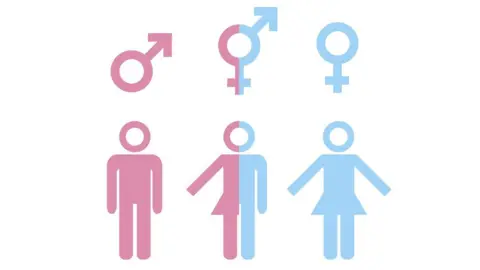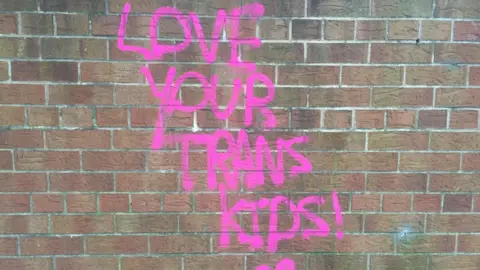School transgender support guidelines published
 BBC
BBCThe first detailed guidelines for schools in Northern Ireland on how to support transgender pupils have been published.
The guidance is from the Education Authority (EA).
It covers things like uniforms, naming, use of toilets and changing rooms, access to sports and admissions to single-sex schools.
The guidance is non-statutory but the EA says it reflects best practice in supporting transgender pupils.
It applies to pre-schools, primary schools, post primary and special schools as well as other educational and youth service settings.
The EA drew up the guidance after consultation with a number of different organisations.
According to a definition in the guidance, transgender people "have a gender identity which differs from that of their (assigned) birth sex".
A trans boy, for instance, is "a birth-assigned female whose gender identity is male".
Post-primary guidance
While there are no reliable statistics on the number of transgender people in Northern Ireland, the EA cites research on gender identity that suggests between 0.17% and 1.3% of adolescents and young adults identify as transgender.
While primary school staff are advised to support a younger child who is exploring their gender identity - for instance, by wearing clothes stereotypically associated with the gender they identify with - most of the guidance is aimed at post-primary schools.
"It is important that the young person feels supported and that their best interests are promoted," the EA guidance states.
The guidance recommends that each school should appoint a designated staff member to be the first point of contact for pupils who are questioning their gender identity.

It recommends a number of practical measures a school should take to support a pupil who is transitioning.
School staff are advised to inform a pupil's parents that the young person is identifying as transgender.
However, this should only be done with the consent and knowledge of the pupil.
Teachers are advised to be "sensitive to the needs of transgender pupils, as well as the needs of other pupils" when making decisions about the use of toilets and changing rooms.
"Where requested, staff should give a transgender pupil access to toilets which match their gender identity, unless there is a good reason not to do so," the guidance states.
It also recommends that reasonable efforts should be made to allow transgender pupils to use changing rooms that match their gender identity.
However, the guidance says "this should be assessed on a case by case basis" although "every way to enable full inclusion should be explored".
If the transgender young person wishes to use separate or gender-neutral toilet or changing facilities, the school should facilitate this.
Teachers are also advised that they should respect a transgender pupil's wishes with regard to what name they are called.
This includes non-binary pupils who do not identify as male or female and may want to be referred to as "they" rather than "he" or "she".
No 'blanket policy'
The guidance says that teachers and school staff may hold different views on transgender people but they do not "have unlimited right to freedom of expression".
For instance, if a teacher repeatedly refuses to call a transgender pupil by their preferred name they are to be made aware that their behaviour is unacceptable.
On uniform, schools are advised to be flexible or to introduce a gender-neutral option.
"A transgender pupil should be allowed to wear the clothing that corresponds to their gender identity, regardless of their sex assigned at birth, unless there is good reason not to," the guidance states.
When it comes to PE and sports the guidance acknowledges that there may be health and safety issues or concerns over fairness.
"Transgender pupils should only be treated differently in respect of their participation in PE and sports if it is necessary to do so to ensure fair competition or the safety of competitors," it says.
However, schools should not have a "blanket policy" of always excluding transgender young people.
"Where staff decide to exclude a transgender young person as a competitor, this should be decided on a case by case basis, based on objective evidence," the guidance states.
Finally, governors of single-sex schools are advised that there is nothing in equality law that prevents a single-sex school from accepting a transgender pupil.
"A pupil who has transitioned or wants to transition should be allowed to continue to attend a single-sex school," it concludes.
The EA said the guidance does not recommend a "one-size-fits-all" approach but is designed to help school staff make decisions to support transgender pupils.
